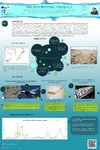Identificador persistente para citar o vincular este elemento:
https://accedacris.ulpgc.es/jspui/handle/10553/16929
| Título: | Microtrophic project: microplastic incorporation in marine food webs | Autores/as: | Herrera-Ulibarri, Alicia Asensio Elvira, María Teresa Martínez, Ico Packard, Theodore T. Gómez, May |
Clasificación UNESCO: | 2599 Otras especialidades de la tierra, espacio o entorno | Palabras clave: | Microplásticos Cadena trófica |
Fecha de publicación: | 2016 | Resumen: | Small pieces of plastic are accumulating in the oceans. Because they are smaller than 5 mm they are called microplastics. They are produced by many different processes of degradation and fragmentation, and can be found washed up on every beach of the world ocean. Recently their size is getting smaller and their abundance increasing. A recent evaluation finds five trillion particles weighing 268,940 tons floating at sea. However, these values are 10 orders of magnitude lower than the total plastic debris dumped into the sea since 1970. Thus, a significant portion of plastic waste has disappeared and one likely cause is ingestion by marine zooplankton and subsequent transfer up the marine food web. There, they pose a biohazard because microplastics absorb persistent organic pollutants (POP’s), including polychlorinated biphenyls (PCB’s) that, via marine fisheries, get transferred to people. Once in people’s bodies, these POPs can penetrate cells, chemically interact with important biomolecules, and disrupt the endocrine system. Because of this danger, it is imperative to estimate microplastic ingestion and egestion rates in zooplankton. Here at the University of Las Palmas on Gran Canaria in the MICROTROPHIC Project, we are determining microplastic abundance and temporal variability. In laboratory cultures of zooplankton, we are determining the ingestion and egestion rates of microplastics. In mesocosm experiments we are investigating microplastic transfer through the food chain and we are studying the relationship between the ingestion of microplastics contaminated with PCBs, and the concentration of PCBs in animals tissues | URI: | https://accedacris.ulpgc.es/handle/10553/16929 | Fuente: | 6th Zooplankton Production Symposium "New challenges in a changing ocean", Scandic Bergen City, Bergen, Norway, 9-13 may 2016 |
| Colección: | Póster de congreso |
Visitas
421
actualizado el 27-ene-2024
Descargas
102
actualizado el 27-ene-2024
Google ScholarTM
Verifica
Comparte
Exporta metadatos
Este elemento está sujeto a una licencia Licencia Creative Commons

